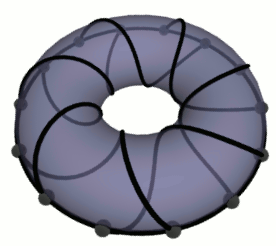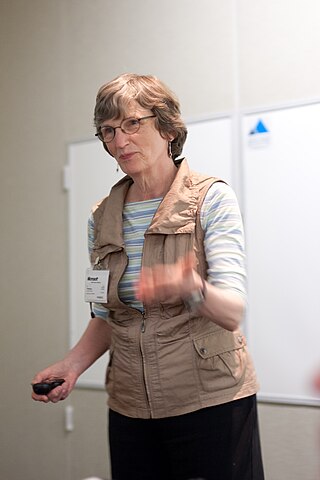Related Research Articles

Donald Ervin Knuth is an American computer scientist, mathematician, and professor emeritus at Stanford University. He is the 1974 recipient of the ACM Turing Award, informally considered the Nobel Prize of computer science. Knuth has been called the "father of the analysis of algorithms".

The Department of Computer Science at the University of Manchester is the longest established department of Computer Science in the United Kingdom and one of the largest. It is located in the Kilburn Building on the Oxford Road and currently has over 800 students taking a wide range of undergraduate and postgraduate courses and 60 full-time academic staff.

Vaughan Pratt is a Professor Emeritus at Stanford University, who was an early pioneer in the field of computer science. Since 1969, Pratt has made several contributions to foundational areas such as search algorithms, sorting algorithms, and primality testing. More recently, his research has focused on formal modeling of concurrent systems and Chu spaces.

In the mathematical field of graph theory, a toroidal graph is a graph that can be embedded on a torus. In other words, the graph's vertices can be placed on a torus such that no edges cross.
Jeffrey David Ullman is an American computer scientist and the Stanford W. Ascherman Professor of Engineering, Emeritus, at Stanford University. His textbooks on compilers, theory of computation, data structures, and databases are regarded as standards in their fields. He and his long-time collaborator Alfred Aho are the recipients of the 2020 Turing Award, generally recognized as the highest distinction in computer science.
Boris (Boaz) Abramovich Trakhtenbrot was a Russian-Israeli mathematician in logic, algorithms, theory of computation, and cybernetics.

Algorithmic art or algorithm art is art, mostly visual art, in which the design is generated by an algorithm. Algorithmic artists are sometimes called algorists.
John Vivian Tucker is a British computer scientist and expert on computability theory, also known as recursion theory. Computability theory is about what can and cannot be computed by people and machines. His work has focused on generalising the classical theory to deal with all forms of discrete/digital and continuous/analogue data; and on using the generalisations as formal methods for system design; based on abstract data types and on the interface between algorithms and physical equipment.

In topological graph theory, an embedding of a graph on a surface is a representation of on in which points of are associated with vertices and simple arcs are associated with edges in such a way that:
R. Nigel Horspool is a retired professor of computer science, formerly of the University of Victoria. He invented the Boyer–Moore–Horspool algorithm, a fast string search algorithm adapted from the Boyer–Moore string-search algorithm. Horspool is co-inventor of dynamic Markov compression and was associate editor and then editor-at-large of the journal Software: Practice and Experience from 2007 to 2017. He is the author of C Programming in the Berkeley UNIX Environment.

Dame Wendy Hall is a British computer scientist. She is Regius Professor of Computer Science at the University of Southampton.
In graph theory, the planarity testing problem is the algorithmic problem of testing whether a given graph is a planar graph (that is, whether it can be drawn in the plane without edge intersections). This is a well-studied problem in computer science for which many practical algorithms have emerged, many taking advantage of novel data structures. Most of these methods operate in O(n) time (linear time), where n is the number of edges (or vertices) in the graph, which is asymptotically optimal. Rather than just being a single Boolean value, the output of a planarity testing algorithm may be a planar graph embedding, if the graph is planar, or an obstacle to planarity such as a Kuratowski subgraph if it is not.

David Galer Kirkpatrick is a Professor Emeritus of computer science at the University of British Columbia. He is known for the Kirkpatrick–Seidel algorithm and his work on polygon triangulation, and for co-inventing α-shapes and the β-skeleton. He received his PhD from the University of Toronto in 1974.
Roman Verostko is an American artist and educator who creates code-generated imagery, known as algorithmic art. Verostko developed his own software for generating original art based on form ideas he had developed as an artist in the 1960s. His software controls the drawing arm of a machine known as a pen plotter that was designed primarily for engineering and architectural drawing. In coding his software Verostko conceives of the machine's drawing arm as an extension or prosthesis for his own drawing arm. The plotter normally draws with ink pens but Verostko adapted oriental brushes to fit the drawing arm and wrote interactive routines for achieving brush strokes with his plotters. In 1995, he co-founded the Algorists with Jean-Pierre Hébert.
Ming C. Lin is an American computer scientist and a former chair of the Department of Computer Science at the University of Maryland, College Park, where she also holds an endowed faculty position as the Elizabeth Stevinson Iribe Chair of Computer Science. Prior to moving to Maryland in 2018, Lin was the John R. & Louise S. Parker Distinguished Professor of Computer Science at the University of North Carolina at Chapel Hill.

Sue Hays Whitesides is a Canadian mathematician and computer scientist, a professor emeritus of computer science and the chair of the computer science department at the University of Victoria in British Columbia, Canada. Her research specializations include computational geometry and graph drawing.
Valerie King is an American and Canadian computer scientist who works as a professor at the University of Victoria. Her research concerns the design and analysis of algorithms; her work has included results on maximum flow and dynamic graph algorithms, and played a role in the expected linear time MST algorithm of Karger et al.
Deborah A. Joseph is an American computer scientist known for her research in computational geometry, computational biology, and computational complexity theory. She is a professor emeritus of computer science at the University of Wisconsin–Madison.
Harold N. (Hal) Gabow is an American computer scientist known for his research on graph algorithms and data structures. He is a professor emeritus at the University of Colorado Boulder, and the former founding editor-in-chief of ACM Transactions on Algorithms.
References
- ↑ "Emeritus, adjunct, cross-listed, and sessionals", Faculty & Staff, University of Victoria Computer Science
- ↑ Wendy Myrvold at the Mathematics Genealogy Project